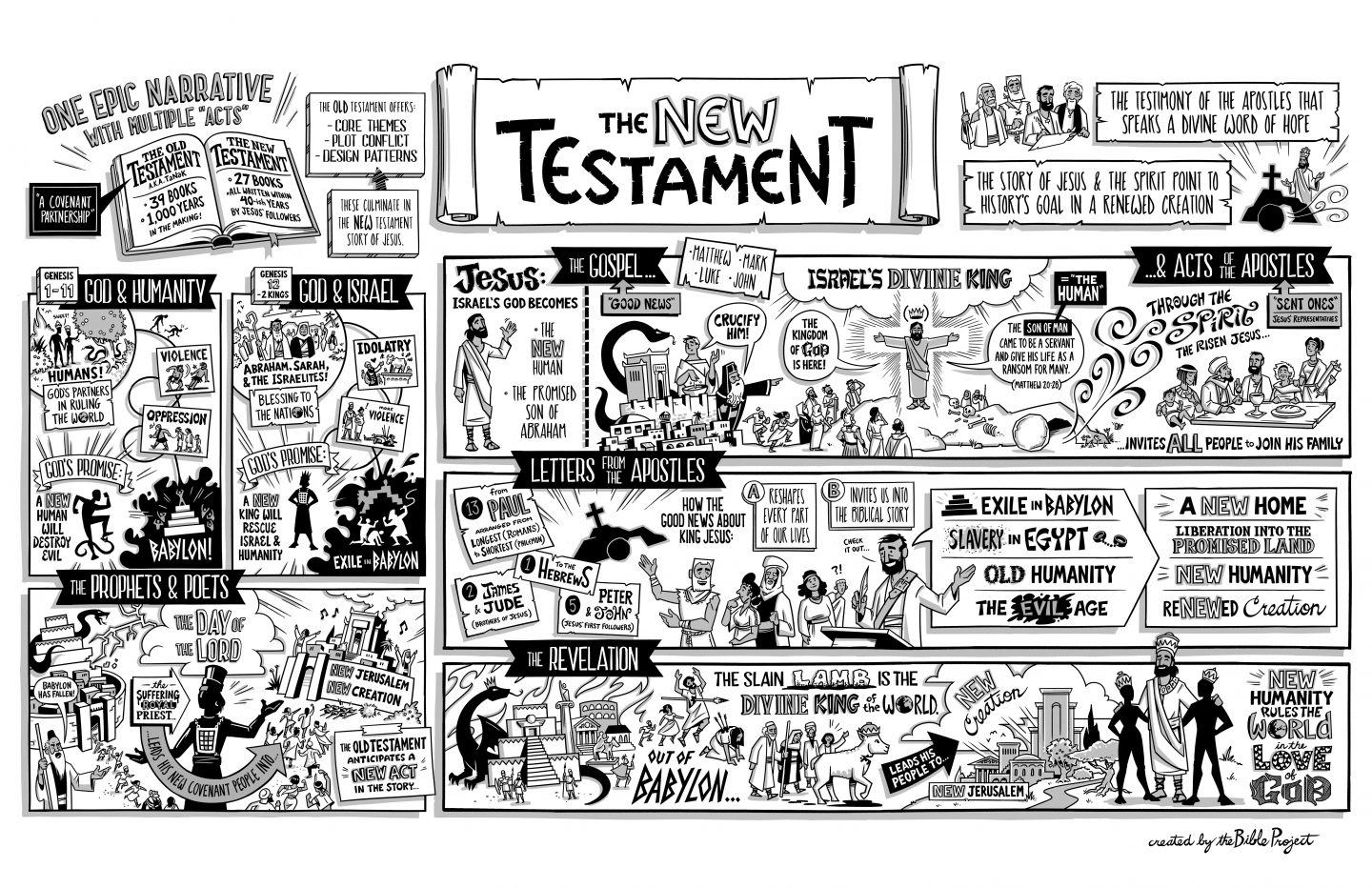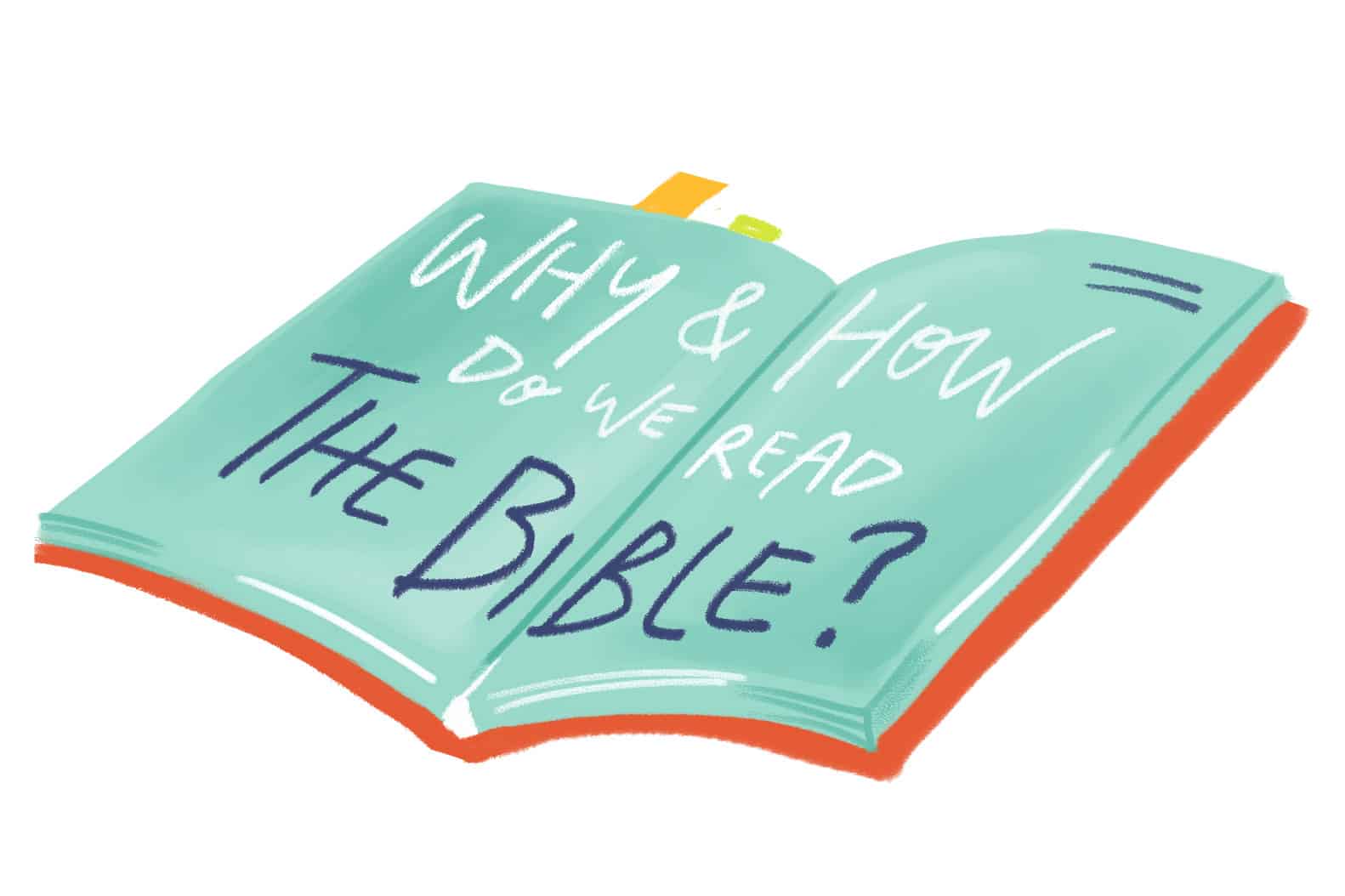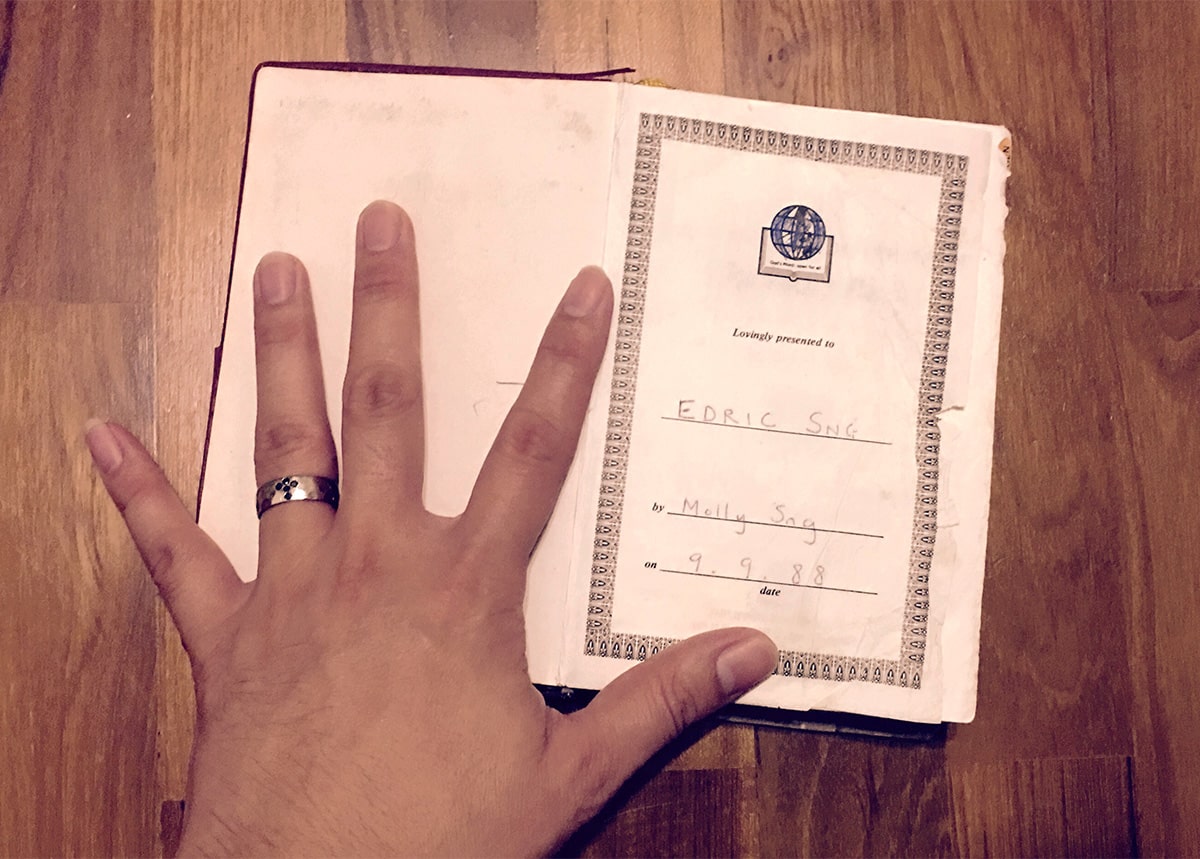Faith 101: Where should I start reading the Bible?
Salt&Light // May 28, 2019, 1:50 pm

An overview of the entire New Testament of the Bible in pictures. This is one of many charts created by The Bible Project which produces animated videos. Photo by The Bible Project.
The Bible is the world’s best-selling book of non-fiction, according to Guinness World Records!
That, in itself, may not be a compelling reason to read the Bible. But more compelling is this: The Bible is where you can encounter God.
Literally speaking, the Bible is a collection of 66 separate “books” – 39 books under the Old Testament, and 27 books under the New Testament. These books are ancient scripts of different writing styles, including narrative, poetry, songs, and prose, in forms ranging from letters to laws. They were originally written in Hebrew and Greek, but have since been translated into a multitude of languages.
You will find timeless wisdom in the Bible for living, and a treasure trove of truths about God and the world we live in, both seen and unseen.
To find out more, check out The Bible Project – an animated video guide to reading the Bible.
What’s so important about reading the Bible?
Christians believe that the Bible is the Word of the Creator God (John 1:14).
It is common to hear Christians say, “God said…”, and you might wonder how?
While God is not one to be boxed in and limited by our understanding of His ways, one channel that God speaks to us is through His word, which is described by the writer of Hebrews as “alive” (Hebrews 4:12).
It is common to hear Christians say, “God said …”, and you might wonder: How?
In the book of 2 Timothy, the Apostle Paul tells his disciple, Timothy, that “all Scripture is God-breathed”. One translation translates it more simply as “inspired by God” (2 Timothy 3:16, NLT).
The purpose of the Bible? “To prepare and equip His (God’s) people to do every good work.” (2 Timothy 3:17, NLT)
No one enters into a new relationship without communication; as a child of God, our relationship with God is no different.
God desires to speak to us and He often does it through what He has already revealed in the Bible, the word of God (1 Thessalonians 2:13).
Where should I start?
Unlike most books that are meant to be read from front to back, the Bible comprises of 66 books that could be more accurately described as a “library” of holy texts. It is possible to read the Bible from sequentially from start to end, but you might get stuck by the time you get to Leviticus, the third book, full of do’s and don’ts.
To help you get started, here’s our recommended order of books to whet your appetite. (A quick google will suggest many other equally readable lists):
1) Gospel of JOHN: Learning who Jesus is
Start with one of the four Gospels (Matthew, Mark, Luke and John) in the Bible. They give an account of Jesus’ life and teachings here on earth, and central to our faith is the historical figure of Jesus Christ, who is God Himself who “became flesh, and dwelt among us” (John 1:14).
Seven times, Jesus answers “I Am” when people question His identity.
The Gospel of John is a great place to start because it was “written to help you believe that Jesus is the Messiah … and that by believing you may have life in his name.” (John 20:31).
Introduction to the book: Throughout the Gospel of John, we see that Jesus is God.
Not only is Jesus the Messiah (Saviour), He’s also the Son of God who gives eternal life to everyone who believes in His name. We see this reality through the signs and miracles He performs, and seven times He answers “I Am” when people question His identity.
2) The book of ACTS: What happens next
The book of Acts continues the story of the Gospel and how it changed life on earth after Jesus came. It is a powerful testimony of how the early church was established by the work of the Holy Spirit – and it is easy to see how that work is continuing today, even in the Church in Singapore.
Introduction to the book: Before Jesus was taken to heaven, He instructed His followers to be a witness for Him. Jesus’ followers received the Holy Spirit on Pentecost and became filled and equipped to spread the good news that would restore God’s kingdom over the world. Through persecution, the believers were scattered. They continued to preach, and the church at Antioch was born.
It grew into the first multiethnic, international church from which missionaries were sent throughout the world to preach about Jesus.
3) A letter to believers: EPHESIANS
Unlike the gospel of John and the book of Acts, Ephesians is a letter from the Apostle Paul to the believers in Ephesus.
“Christianity begins not with a big DO, but with a big DONE … God has already “blessed us with every spiritual blessing”.
Watchman Nee, a Chinese church leader and teacher, distils the essence of Ephesians into three simple words: Sit. Walk. Stand, and says Ephesians “abounds with spiritual riches, and yet is … intensely practical.”
He writes: “Christianity does not begin with walking; it begins with sitting.
“For Christianity begins not with a big DO, but with a big DONE. Thus Ephesians opens with the statement that God has “blessed us with every spiritual blessing in the heavenly places in Christ”. (Ephesians 1:3) And we are invited at the very outset to sit down and enjoy what God has done for us; not to set out to try and attain it for ourselves.”
Introduction to the book: In the book of Ephesians, we see how the Gospel story affects believers’ everyday lives. God, the Father, planned throughout history for Jesus to create a multi-ethnic community of followers. Consisting of Jews and non-Jews, these followers form the “family” God promised to Abraham. They live in unity as one body in their families, neighbourhoods, and churches because of God’s grace.
4) GENESIS: Where it all began
In the Old Testament, Genesis, which means “origin”, is a good starting point too. Reading this narrative about the beginning of the world, how sin came to be and the impact it had on the world, gives us a reference point to start understanding the context of the New Testament.
Many famous Bible stories like Adam and Eve, Noah’s ark, and the story of Joseph (Prince of Egypt, the movie, anyone?) are found in Genesis.
Introduction to the book: The Book of Genesis tells us how everything began from humanity’s history to become the world we know today. It reveals a dramatic prologue of God’s love for us, the tragedies of sin and the human race, and God initiating a brilliant plan to win us back from the clutches of darkness.
He does this by passing down a covenant blessing through Abraham and his family, including Isaac, Jacob, and other individuals, in order to bless all the families of the earth.
These descendants will become the foundation for the nation of Israel and Jesus the Messiah, who brings salvation for all of humanity.
5) PSALMS: An expression for every feeling
This book of poetry is a great place to find encouragement. In it, you can find the entire spectrum of human feelings expressed in song and poetry unto God. Find comfort in knowing that God values your feelings and has given the expression a significant portion of His Word. Often, many people find comfort in praying through the Psalms.
Introduction to the book: Part of the first five books of the Old Testament, the Book of Psalms is a remarkable collection of poems from David, Moses, and other Jewish writers. Through the Psalms, we learn about the importance of prayer and the acknowledgment of pain, as well as the power of praise and fulfilment of prophecy.
Here are some Psalms that are frequently spoken of:
Psalm 1: Psalm of wisdom
Psalm 23: Confession of trust
Psalm 46: Song of praise
Psalm 51: Prayer of lament
Psalm 91: Confession of trust
Psalm 139: Prayer of lament
The introductions to each book listed here have been republished from The Bible Project with permission. Videos of most books of the Bible are also available in Mandarin, Cantonese, Bahasa Indonesia, Hindi and Telugu.
So many versions of the Bible ... Which one should I use?
Since it is unlikely that you’ll begin reading the Bible in its original languages (i.e. old Hebrew and ancient Greek), pick any version of the English Bible to start with.
The Bible is God’s Word to us, and He will use it to speak to you, no matter which version you choose.
The technicalities of the translation process can seem like Greek, so suffice to say that major Bible translations differ mainly between a “meaning-for-meaning” and “word-for-word” translation.
Some examples of “word-for-word” translation include the English Standard Version (ESV) and the New King James Version (NKJV) – these aim to preserve the original order of the text in English. In contrast, the New Living Translation (NLT) is a “meaning-for-meaning” translation where the focus is on rendering the idea of the text most accurately. Two versions – the New International Version (NIV) and the Holman Christian Standard Bible (HCSB) fall somewhere in between.
(If you are interested, this article explains a little more about translations and the spectrum of versions.)
Pro tip: It is common to use different translations to gain a better understanding of the particular verse you are reading. (The New Living Translation (NLT) or Amplified Bible (AMP) are good options, and this website, BibleHub, shows close to 20 translations for every verse.)
We are an independent, non-profit organisation that relies on the generosity of our readers, such as yourself, to continue serving the kingdom. Every dollar donated goes directly back into our editorial coverage.
Would you consider partnering with us in our kingdom work by supporting us financially, either as a one-off donation, or a recurring pledge?
Support Salt&Light




